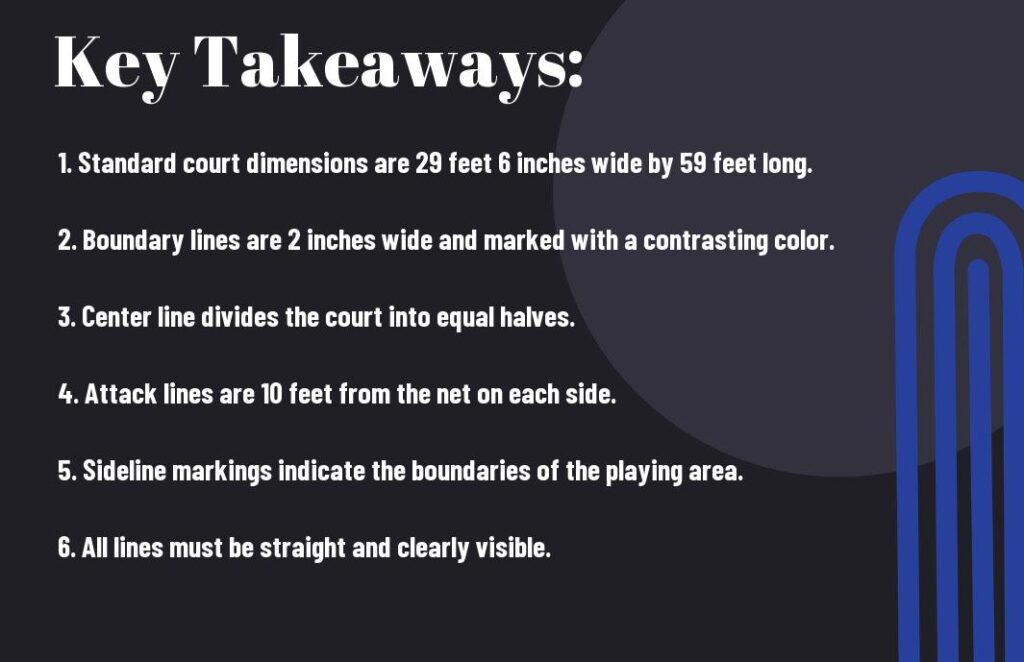Have you ever wondered about the specific rules for line markings on a volleyball court? Understanding these rules is crucial to playing the game safely and fairly. The boundary lines are essential for determining whether a ball is in or out of play, and misinterpreting them can result in penalties or lost points. However, knowing and respecting these rules can greatly improve your game and ensure a smooth and enjoyable experience for all players. Let’s delve into the specific regulations and requirements for line markings on a volleyball court.
Key Takeaways:
- Regulation measurements: Line markings on a volleyball court must adhere to official regulations, including the overall dimensions of the court, and placement of boundary lines and attack lines.
- Distinctive colors: The lines must be clearly marked in a specific color to differentiate between the boundary lines, attack lines, and center lines, ensuring clear visibility and minimal confusion during gameplay.
- Uniformity and consistency: The lines on a volleyball court must be consistently straight and of equal width, providing a level playing field for all teams and players. Any discrepancies in line markings could lead to a disadvantage during official matches.

Detailed Overview of Volleyball Court Line Markings
Clearly, understanding the specifications and regulations for volleyball court line markings is essential for ensuring a fair and safe game. The precise placement and measurement of these lines are crucial for maintaining the integrity of the game and providing a level playing field for all competitors. In this section, we will provide a detailed overview of the line markings on a volleyball court, including their distinctive features and the importance of accurate placement.
Distinctive Features of Line Markings
When you step onto a volleyball court, you will notice several distinct line markings that define the boundaries and zones of the playing area. The most prominent line is the boundary line, which outlines the perimeter of the court. This line is critical for determining whether a ball is in or out of play. Additionally, you will see the attack line, which separates the front and back zones of the court and plays a crucial role in regulating player positions during a game. These distinctive features of line markings serve as visual cues for players and officials, ensuring that the game is played within the designated boundaries and according to the rules.
Importance of Accurate Line Markings
Ensuring that the line markings on a volleyball court are accurately placed is of utmost importance for several reasons. Firstly, accurate line markings ensure that the game is played fairly, without any ambiguity regarding the location of the ball in relation to the boundaries. This is essential for making accurate calls during the game and maintaining the integrity of the competition. Moreover, accurate line markings help prevent injuries by providing players with a clear understanding of the limits of the playing area. By adhering to the proper measurements and placement of line markings, you can help create a safe and professional environment for volleyball matches.
Specifications for Line Markings on a Volleyball Court
Lastly, when it comes to the line markings on a volleyball court, it is important to understand the specific specifications that are required to ensure the court meets the necessary standards. For more detailed information on this topic, you can also check out this comprehensive guide on Volleyball Court Lines, Markings and Player Positions.
Particulars of Thickness and Colour for Line Markings
The line markings on a volleyball court must adhere to specific standards regarding their thickness and color. The lines should be 5cm (2 inches) in width and a bright, contrasting color to the floor surface to ensure visibility for both players and officials. This helps to clearly define the boundaries of the court and minimize the risk of potential disputes during the game.
Required Distances and Positions for Line Markings
In addition to the thickness and color, the line markings on a volleyball court must also be positioned at specific distances from each other. The center line, attack line, and end lines are all carefully measured and marked to ensure the court is regulation size and players are positioned correctly during play. This helps to maintain the integrity of the game and ensure fair play for all teams involved.
Violations and Consequences of Improper Line Markings
After learning about the essential line markings on a volleyball court, it is essential to understand the violations and consequences that may arise from improper line markings. When the lines on the volleyball court do not adhere to the standard dimensions and measurements, it can lead to serious violations and impact the outcome of the game. To ensure that you are following the correct guidelines, refer to the Guide To Volleyball Court Dimensions & Lines for accurate information on measurements and markings.
How Faults are Determined Based on Line Markings
It is important to recognize that the proper line markings on a volleyball court play a critical role in determining faults during the game. The boundaries and center lines are used to determine whether the ball is in or out of play, and whether a player’s position is within the correct zone. Incorrect line markings can lead to incorrect calls, disrupting the flow of the game and potentially impacting the fairness of the match. Therefore, it is crucial to maintain accurate line markings at all times.
Penalties and Consequences of Line Marking Violations
When it comes to line marking violations, the consequences can be severe. If the court lines do not meet the standard regulations, the game may be subject to interruptions and delays while the issues are addressed. In some cases, failure to rectify line marking violations can lead to the disqualification of the venue for hosting volleyball matches. This can be a significant issue for both players and organizers, emphasizing the importance of maintaining proper line markings on the volleyball court.
The Rules for Line Markings on a Volleyball Court
The rules for line markings on a volleyball court are essential for maintaining fairness and consistency during a game. It is important to remember that the dimensions and placement of the lines are regulated by official volleyball regulations, and as a player or organizer, it is your responsibility to ensure that the court lines are properly marked and maintained. Proper line markings not only contribute to the safety of players but also ensure that the game is played according to set guidelines. Understanding and adhering to these rules will help you create a professional and fair playing environment for all participants.
FAQ
What are the rules for line markings on a volleyball court?
The standard volleyball court is 18 meters long and 9 meters wide, with a centerline dividing it into two equal halves. The sidelines are 9 meters long, and the end lines are 8 meters long. The court is marked with various lines, including the attack line, service line, and center line, each serving specific purposes within the game.
What is the purpose of the attack line on a volleyball court?
The attack line, also known as the 3-meter line, is located 3 meters away from the net on each side of the court. Its primary purpose is to dictate the area where back row players are allowed to jump and spike the ball. Front row players are not permitted to spike or attack the ball from behind this line.
What are the rules for the centerline and service line on a volleyball court?
The centerline divides the court into two equal halves and is used to determine the position of players during the game. For example, back row players are not allowed to reach over the centerline to play the ball. The service line is located at the back of the court and serves as the starting point for serving the ball. When serving, the player must stand behind the service line and may not step over it until after making contact with the ball.



